11 Foods that Resemble Body Parts
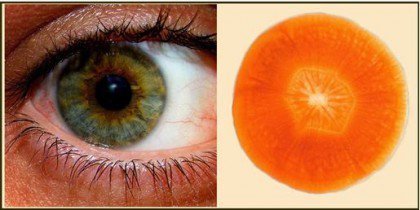

Written and verified by the psychologist Raquel Aldana
Have you ever wondered why there are some foods that resemble body parts? How about the claim that these foods are better for the parts of the body they resemble than for others? Today we’ll be exploring these special foods and theories about their supposed effectiveness.
“The study and contemplation of nature are foods for the heart and mind.”
Cicero
Most of us believe that nature is wise, but such obvious signals would be shocking indeed.
Some people believe that nothing Mother Earth does is random or without reason. Everything, they claim, has a purpose, even though we may not be able to see at first glance. With these ideas in mind, let’s take a look at 11 of the most surprising foods that resemble body parts.
Foods related to Body Functions
1. Carrots and the eyes
Carrots are one of the best health foods. They can be especially important for your vision thanks to their high beta carotene content. They also contain significant amounts of vitamins A, C, B1, B2, B3, B6, B9, C, E, K and coline. Aside from vitamins, carrots have minerals like potassium, magnesium, iron, calcium and phosphorus. This makes the carrot one of the best health foods you can eat.
These nutrients are especially important to vision health. As an example, Vitamin A deficiency causes night blindness. This vitamin also helps prevent cataracts and age-related macular degeneration.
If you were to cut a carrot across the width, you’d see that the carrot is one of the foods that resemble body parts. You’d marvel at how the interior resembles the silhouette of a human eye. You’d notice how the lines resemble the pupil and iris.
Be forewarned that although cooking carrots brings out their sweet flavor, it causes them to lose their antioxidants properties that are beneficial to the visual system.
Carrots are mostly made up of carbohydrates. They’re a source of dietary fiber that doesn’t contain saturated fats or cholesterol. In addition, their low calorie content (40 calories per 3.5 ounce serving) makes them great for diets.
2. Strawberries and the teeth
As you can see in the image below, the strawberry is one of the foods that resemble body parts. Looking at the interior of half a strawberry shows you that it’s really similar to the image of the same perspective on a tooth. On top of being a natural teeth whitener, strawberries promote strong, healthy, teeth. Some studies show that they may also promote the health of the gums and oral cavity.
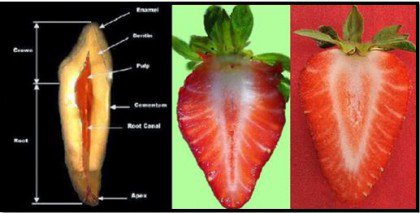
3. Ginger and the stomach
Another item at the top of the list of healthy foods, ginger has been used in Oriental medicine for centuries to calm upset stomachs. If you look closely, you’ll see that specimens of this food often have a similar shape to the stomach.
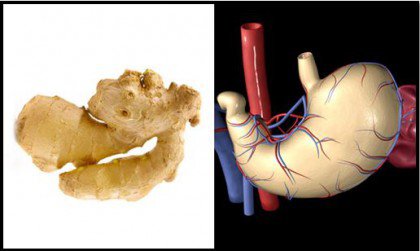
4. Tomato and the heart
If you look at a tomato that’s been cut in half, you’ll notice that it has different compartments where the seeds are located. This distribution is strikingly similar to that of the heart.
Tomatoes are one of the top health foods. They are rich in licopene, a vegetable pigment that protects the heart from cardiac disease and counteracts the negative effects of cholesterol.
Curiously, there are other foods which lack the characteristic red color, yet contain licopene, like beans and parsley.
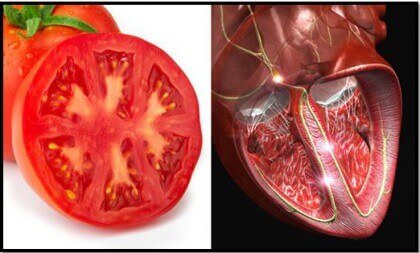
5. Beans and the kidneys
The physical similarities between beans and the kidneys is obvious even at first glance. These legumes have a strong cleansing effect on this organ. In traditional Chinese medicine they’re used to improve and strengthen renal function.
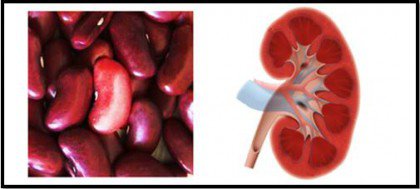
6. Oranges and the mammary glands
Oranges, lemons, limes and grapefruit bear an extraordinary resemblance to human breasts. They contain properties that promote the natural lymphatic drainage of the mammary glands. Some studies show that they may also inhibit the development of cancer cells in the breasts.
See Also: Things to Know About Breast Cancer
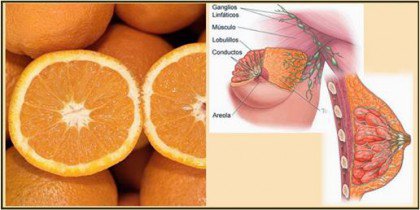
7. Figs and the sex organs
Some people claim that figs increase libido and fertility in both sexes. In addition, this fruit contains large quantities of Vitamin B6, which is responsible for the secretion of serotonin, the happiness hormone.
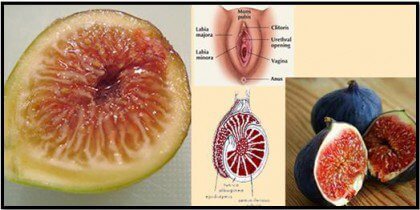
8. Nuts and the brain
Nuts are great for the brain due to their high content of omega-3, omega-6, and omega-9 fatty acids. What’s truly surprising is that the folds, wrinkles, and even the shape of the shell look very much like the the cerebral layout of humans.
Nuts maximize the development of neurotransmitters and help maintain the chemical balance in the brain. There are studies that support the fact that consuming nuts regularly helps fight issues like depression and dementia.
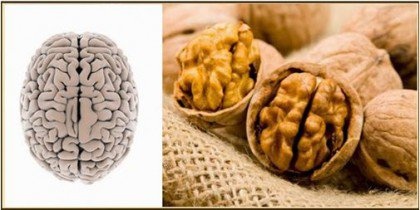
9. Avocado and the uterus
As you can see, the shape of an avocado is really similar to that of the female uterus. On top of the many benefits it provides, here are some interesting facts:
- Avocados contain folic acid, a substance that may be important to fertility.
- Consumption of folic acid reduces the risk of cervical dysplasia, a precancerous illness.
- Another interesting fact is that the avocado takes 9 months to mature from its flower state. This is the same amount of time it takes a human baby to grow in the mother’s womb.
Read Also: 13 Reasons to Eat More Avocados
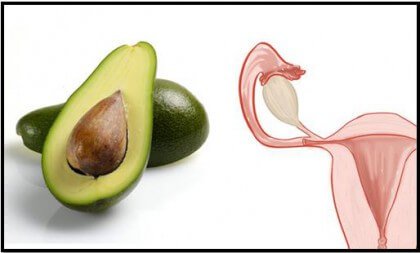
10. Celery and the bones
Celery has a bone-like appearance, so it’s fascinating that eating it may be good for bone strength. The radius and ulna of the arm are like long, slender stalks of celery.
This food contains high concentrations of silica, which is important for strengthening the bones. In addition, it’s rich in calcium, another element necessary for our bones to stay healthy. Their striking similarities go even further: both bones and celery are composed of 23% sodium.
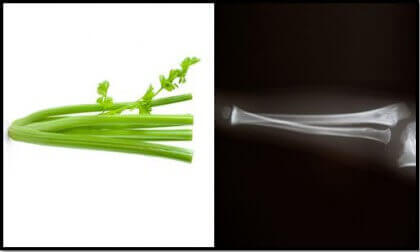
11. Bananas and the hands
It’s well known that bananas are high in potassium, which is necessary for healthy joints. It also lowers your risk of suffering joint and muscular degeneration.

All cited sources were thoroughly reviewed by our team to ensure their quality, reliability, currency, and validity. The bibliography of this article was considered reliable and of academic or scientific accuracy.
- Rocha F., Yumi Sugahara L., Leimann FV., De Oliveira SM., et al., Nanodispersions of beta carotene: effects on antioxidant enzymes and cytotoxic propertires. Food Funct, 2018. 9 (7): 3698-3706.
- Haniadka R., Saldanha E., Sunita V., Palatty PL., et al., A review of the gastroprotective effects of ginger (Zingibeer officinale Roscoe). Food Funct, 2013. 4 (6): 845-55.
- Costa Rodrigues J., Pinho O., Monteiro PRR., Can lycopene be considered an effective protection against cardiovascular disease? Food Chem, 2018. 245: 1148-1153.
- Mesripour A., Hajhashemi V., Kuchak A., Effect of concomitant administration of three different antidepressants with vitamin B6 on depression and obsessive compulsive disorder in mice models. Res Pharm Sci, 2017. 12 (1): 46-52.
- Deacon G., Kettle C., Hayes D., Dennis C., Tucci J., Omega 3 polyunsaturated fatty acids and the treatment of depression. Crit Rev Food Sci Nutr, 2017. 57 (1): 212-223.
This text is provided for informational purposes only and does not replace consultation with a professional. If in doubt, consult your specialist.








